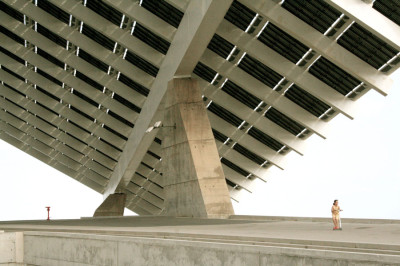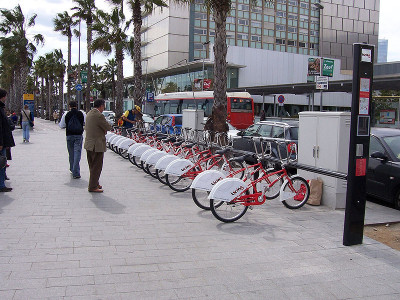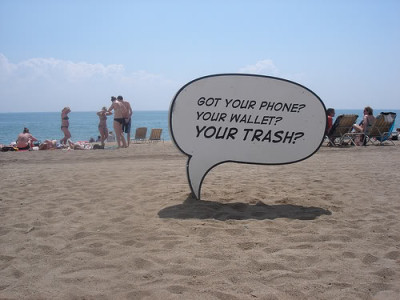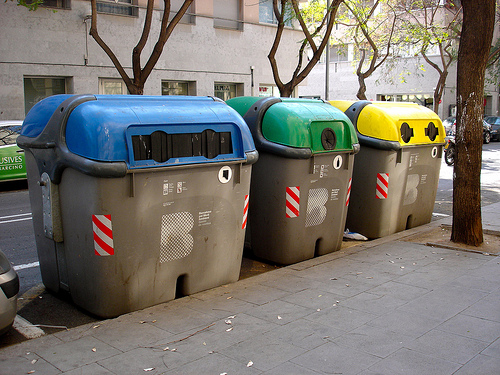Postcard from Barcelona
Looking at the Catalonian path to sustainability

Flying into Barcelona, it becomes immediately obvious that this is a city with its eye on a sustainable future. Right along the waterfront is a large photovoltaic array, perched on four giant supports. It is emblematic of a broader set of initiatives that, for a short time, placed Spain at the forefront of renewable energy deployment.
But Barcelona’s efforts toward sustainability are much broader and deeper than a showcase solar installation. As is true with every ancient city, the core of Barcelona is entirely walkable – human-scale passages, commercial and cultural density providing many attractions in close proximity, and lots of good reasons not to drive a car. Streets are often very narrow and managed in a series of one-way paths that is not always predictable. Parking is available but not always obvious. Barcelona has emphasized the creation of enormous public plazas, encouraging major events that attract throngs to the city center.
Public transit is one of the many things of which Barcelona can be proud. Its Metro subway system offers so many different lines that it is hard to count them, creating a cobweb of interconnecting paths throughout the city. The trains run almost all of the time, and the average wait time for a train is less than two minutes. Compare that to the San Francisco Bay Area’s BART which shuts down every night and features scheduled arrivals that are often 20 minutes apart. BART uses a distance-based pricing system and a one-way ride can exceed seven dollars. Metro in Barcelona uses a postage stamp rate (distance doesn’t matter) and the price with a ten-ride pass is less than one euro. The bus system in Barcelona is also extensive and similarly low-priced. Transfers are free while travel is in one direction. The result of all of this is that the Metro trains and buses are happily crowded day and night.
In addition to Metro, there are several large and busy indoor train stations throughout the city. Compare that to the open-air small platforms in the Bay Area – all that is needed to support to limited Amtrak and regional trains. Sleek, high-speed trains criss-cross the region in Spain and beyond. Train times are frequent. The schedule shows 30 weekday trains to Madrid – at least one per hour, sometimes as frequently as every 20 minutes. There are 56 daily trains to nearby Tarragona (where I am teaching, this semester), some less than eighteen minutes apart.

Barcelona also keeps people out of cars by offering a rather amazing bike share program. Six thousand bikes are spread across the city in 400 different locations. Users slap a magnetic card onto a small plate and grab a bike off the rack. For 46.46 euros a year, the first half hour of each usage is free. That’s usually plenty of time to get where you need to go and place the bike in another rack, but extra time is only another .70 euros per half hour. When you are ready to return to the starting point, just take another bike and ride it back. A smart phone app lets you track the availability of bikes and docking stations. In the first year alone, the bikes reportedly were used for over eight million kilometers of travel.
The city maintains what is said to be at least 128 kilometers of bike lanes, many of which are physically separated from other vehicle traffic. Bikes are often welcome on the broad sidewalks available in many areas. Streets wide and narrow accommodate a peaceful flow of pedestrians, bicyclists and motorists – all in the same space. In some places, throw in a bus or two for good measure.

 In much of Spain, including Barcelona, solid waste management is “in your face”. People need to bring their waste to a public place near where they live or work and deposit it in marked containers dividing food waste from dry, and recyclables from general trash. In this way, managing and reducing waste becomes a matter of public consciousness.
In much of Spain, including Barcelona, solid waste management is “in your face”. People need to bring their waste to a public place near where they live or work and deposit it in marked containers dividing food waste from dry, and recyclables from general trash. In this way, managing and reducing waste becomes a matter of public consciousness.
Lest I appear to be claiming that Barcelona represents environmental perfection, let me be quick to level the balance. Where there is traffic, there is congestion. There is a painful amount of unnecessary packaging for consumer goods. Milk and juices come in one liter, not-very-recyclable coated paper boxes. When a store sells larger quantities of liquid, it is in multiple one-liter boxes bound together with plastic. Some stores insist that you wrap your overall purchase in more plastic and seal it before departing. There is an odd love affair with bottled water. Restaurants never offer any other kind, and drinking fountains are scarce. In the law school where I teach, how many fountains and hydration stations are there? Zero. None. Go to the cafeteria, and you will find a sea of plastic one-use water bottles. All of this while the tap water is perfectly drinkable.
Yet, as is true in the U.S. and in many other countries, cities large and small have dedicated much of their creative energy to enhancing sustainability. At another time, I will write more about the creative Mayor, Vice Mayor, and City Architect of Tarragona, who are working diligently to make their city as green as possible.







One Reply to “Postcard from Barcelona”
Comments are closed.